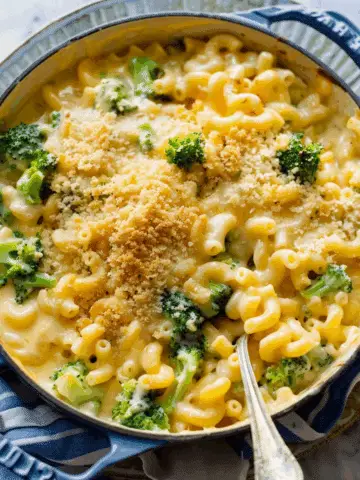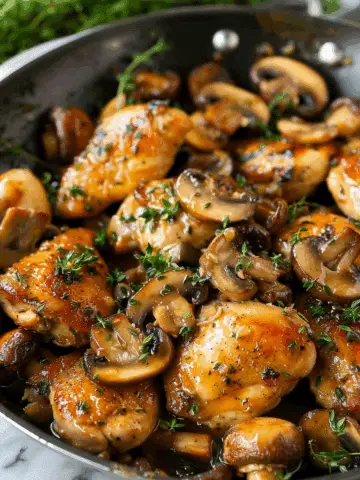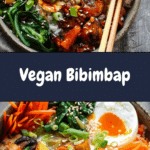A colorful and nourishing Korean-inspired dish, Vegan Bibimbap is my go-to when I’m craving something comforting yet vibrant. It features a mix of sautéed vegetables, crispy tofu, and a spicy, umami-packed gochujang sauce—all beautifully arranged over warm, fluffy rice. It’s as satisfying to look at as it is to eat.
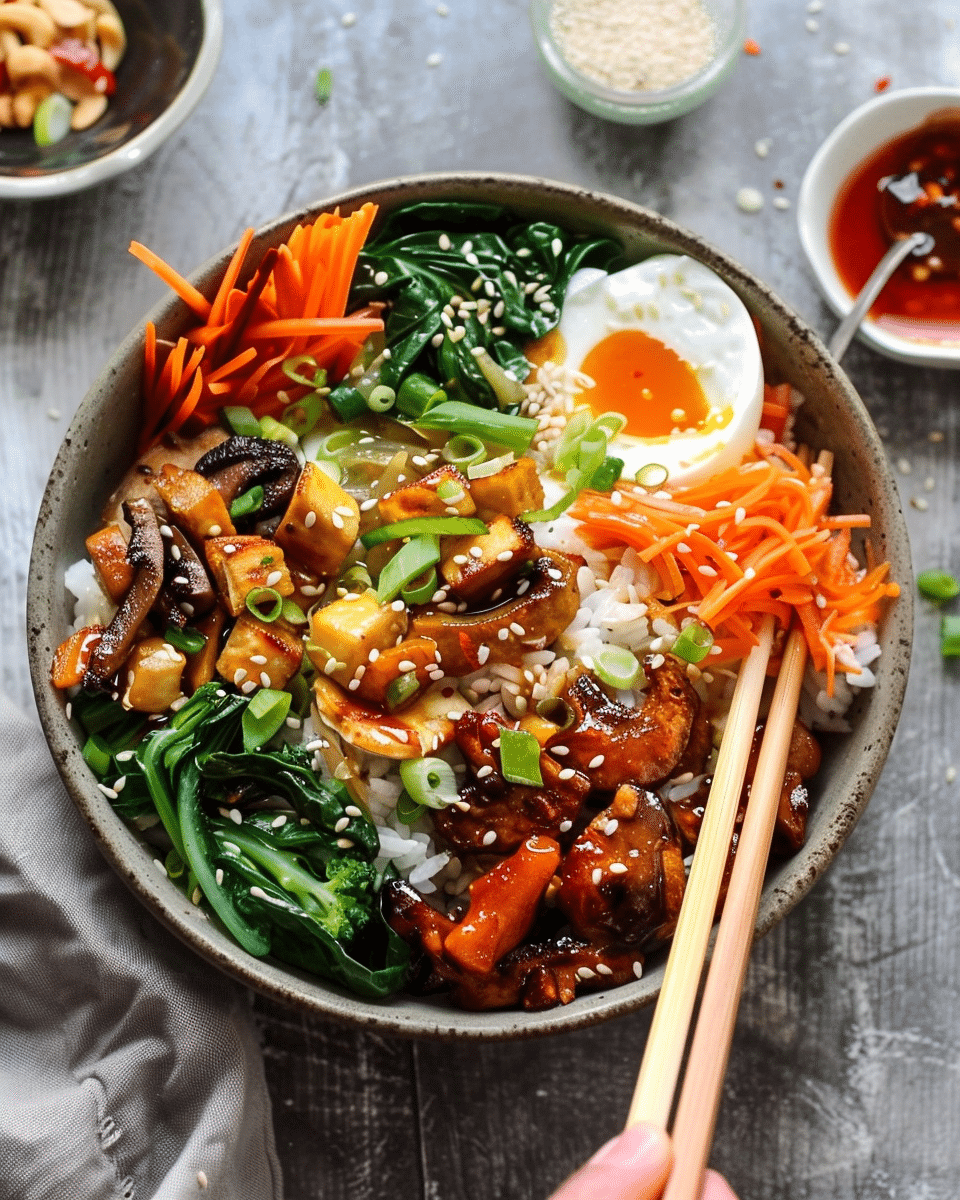
Ingredients
(Tip: You'll find the full list of ingredients and measurements in the recipe card below.)
1 ½ cups jasmine or short-grain rice
1 tablespoon sesame oil
1 tablespoon vegetable oil
1 small zucchini, julienned
1 carrot, julienned
1 cup bean sprouts
1 cup shiitake mushrooms, sliced
1 cup spinach
1 cup firm tofu, pressed and cubed
1 garlic clove, minced
1 tablespoon soy sauce
1 tablespoon rice vinegar
1 teaspoon maple syrup
1 tablespoon gochujang (Korean chili paste)
1 teaspoon toasted sesame seeds
2 scallions, chopped
Salt and pepper to taste
Directions
I cook the rice according to the package instructions and keep it warm once it’s done.
In a nonstick skillet, I heat sesame oil over medium heat, then cook the tofu until golden brown on all sides, about 7–10 minutes. I set it aside.
Using the same skillet, I sauté each vegetable (zucchini, carrot, mushrooms, spinach, and bean sprouts) separately with a bit of vegetable oil, garlic, and a pinch of salt. I cook each for 2–3 minutes until just tender and set them aside.
I mix soy sauce, rice vinegar, maple syrup, and gochujang in a small bowl to make the sauce.
To assemble, I divide the rice between bowls and neatly arrange the tofu and vegetables in sections on top.
I drizzle the sauce over everything and finish with sesame seeds and chopped scallions.
Before eating, I mix it all together for the perfect bite.
Servings and timing
Servings: 2
Prep Time: 15 minutes
Cooking Time: 20 minutes
Total Time: 35 minutes
Calories: 410 kcal per serving
Variations
I sometimes use brown rice or quinoa for a heartier base.
When I want extra heat, I add a bit more gochujang or sliced red chili.
If I’m out of tofu, tempeh or seitan works great as a substitute.
For a gluten-free version, I use tamari instead of soy sauce.
I love adding kimchi on top for a fermented, tangy crunch.
Storage/Reheating
If I have leftovers, I store the components separately in airtight containers in the fridge for up to 3 days. When reheating, I warm the rice and tofu in a skillet or microwave and sauté the veggies briefly to refresh them. I always reassemble just before serving and add fresh scallions and sauce for the best flavor.
FAQs
What is bibimbap?
Bibimbap is a traditional Korean rice dish that means "mixed rice." It typically includes rice topped with various vegetables, a protein, and gochujang sauce, all mixed together before eating.
Can I make this dish ahead of time?
Yes, I often prep the veggies and tofu ahead, then just cook the rice and assemble everything when I’m ready to eat. It makes for a quick, healthy lunch or dinner.
Is gochujang very spicy?
Gochujang has a moderate spice level with a bit of sweetness and depth. If I’m sensitive to heat, I use a smaller amount and adjust to taste.
What kind of tofu works best?
I always use firm or extra-firm tofu that’s been pressed to remove excess water. This gives it the best texture when pan-fried.
Can I use other vegetables?
Absolutely. I swap in whatever I have—like bell peppers, kale, or cabbage. It’s a great way to use up seasonal produce.
Conclusion
Vegan Bibimbap is one of those meals that makes me feel nourished and satisfied without feeling heavy. It’s colorful, flavorful, and adaptable to whatever I have on hand. Whether I’m making it for a weeknight dinner or a plant-based meal prep, this bowl always delivers comfort and crunch in every bite.
Recipe:
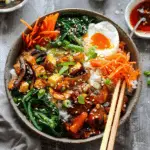
Vegan Bibimbap
5 Stars 4 Stars 3 Stars 2 Stars 1 Star
No reviews
- Author: Cheryl
- Total Time: 35 minutes
- Yield: 2 servings
- Diet: Vegan
Description
A colorful and nourishing Korean-inspired rice bowl, Vegan Bibimbap features sautéed vegetables, crispy tofu, and a spicy-sweet gochujang sauce, all served over warm rice. It's a comforting and customizable plant-based meal.
Ingredients
1 ½ cups jasmine or short-grain rice
1 tablespoon sesame oil
1 tablespoon vegetable oil
1 small zucchini, julienned
1 carrot, julienned
1 cup bean sprouts
1 cup shiitake mushrooms, sliced
1 cup spinach
1 cup firm tofu, pressed and cubed
1 garlic clove, minced
1 tablespoon soy sauce
1 tablespoon rice vinegar
1 teaspoon maple syrup
1 tablespoon gochujang (Korean chili paste)
1 teaspoon toasted sesame seeds
2 scallions, chopped
Salt and pepper to taste
Instructions
- Cook the rice according to the package instructions and keep warm.
- In a nonstick skillet, heat sesame oil over medium heat and cook the tofu until golden brown on all sides, about 7–10 minutes. Set aside.
- In the same skillet, sauté each vegetable (zucchini, carrot, mushrooms, spinach, and bean sprouts) separately with a bit of vegetable oil, garlic, and a pinch of salt for 2–3 minutes each. Set aside.
- In a small bowl, mix soy sauce, rice vinegar, maple syrup, and gochujang to make the sauce.
- Divide the cooked rice between bowls and neatly arrange tofu and sautéed vegetables on top.
- Drizzle the gochujang sauce over the bowl and sprinkle with sesame seeds and chopped scallions.
- Mix everything together before eating for the best flavor experience.
Notes
Swap tofu with tempeh or seitan for variation.
Use tamari instead of soy sauce for a gluten-free version.
Add kimchi or red chili for extra heat and tang.
Store leftovers in separate containers for up to 3 days.
Reheat rice and tofu before assembling; sauté veggies briefly to refresh.
- Prep Time: 15 minutes
- Cook Time: 20 minutes
- Category: Main Dish
- Method: Stovetop
- Cuisine: Korean
Nutrition
- Serving Size: 1 bowl
- Calories: 410
- Sugar: 5g
- Sodium: 550mg
- Fat: 15g
- Saturated Fat: 2g
- Unsaturated Fat: 12g
- Trans Fat: 0g
- Carbohydrates: 55g
- Fiber: 5g
- Protein: 14g
- Cholesterol: 0mg

